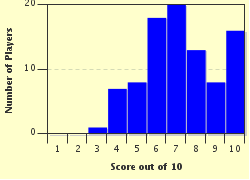Quiz Answer Key and Fun Facts
1. Hanukkah, a Jewish celebration honoring the rededication of the temple at Jerusalem, is also called the Festival of what?
2. The tradition of Hanukkah was born from a miraculous occurrence that was transcribed into the Talmud in which books of scripture?
3. True or False: Most people are familiar with the Hanukkah menorah and its nine branches of candle holders, but is it required that the ninth branch - designated as the "shamash" - be set either higher or lower under Jewish law?
4. A celebration of African-American culture, the word "Kwanzaa" comes from a phrase meaning "first fruits of the harvest" in which African language?
5. Each day of Kwanzaa is dedicated to an individual principle outlined in the tenets of the festival, but how many principles are there to celebrate?
6. True or False: The earliest celebrations of Kwanzaa involved shunning the celebration and symbolism of all other year-end holidays.
7. Christmas has over the centuries incorporated many different traditions, including pagan, Roman and Christian celebrations. Of these worldly contributions, which people contributed the concept of Yule to the Christmas festivities?
8. The Christmas tree was another instance where the pagan practice of decorating with evergreen was incorporated in the holiday celebration. An early Catholic supporter of the Christmas tree, Saint Boniface, indicated that the triangular shape of a fir tree represented what?
9. Advent is a Christian tradition following the time of anticipation awaiting the coming of Christ, both as a child born in a manger and looking for the returning Savior. There is a particular color tied to this observation; that color is what?
10. True or False: Catholics banned the celebration of Christmas during the Protestant Reformation, citing their turn from idolatry.
Source: Author
TemptressToo
This quiz was reviewed by FunTrivia editor
stedman before going online.
Any errors found in FunTrivia content are routinely corrected through our feedback system.

